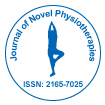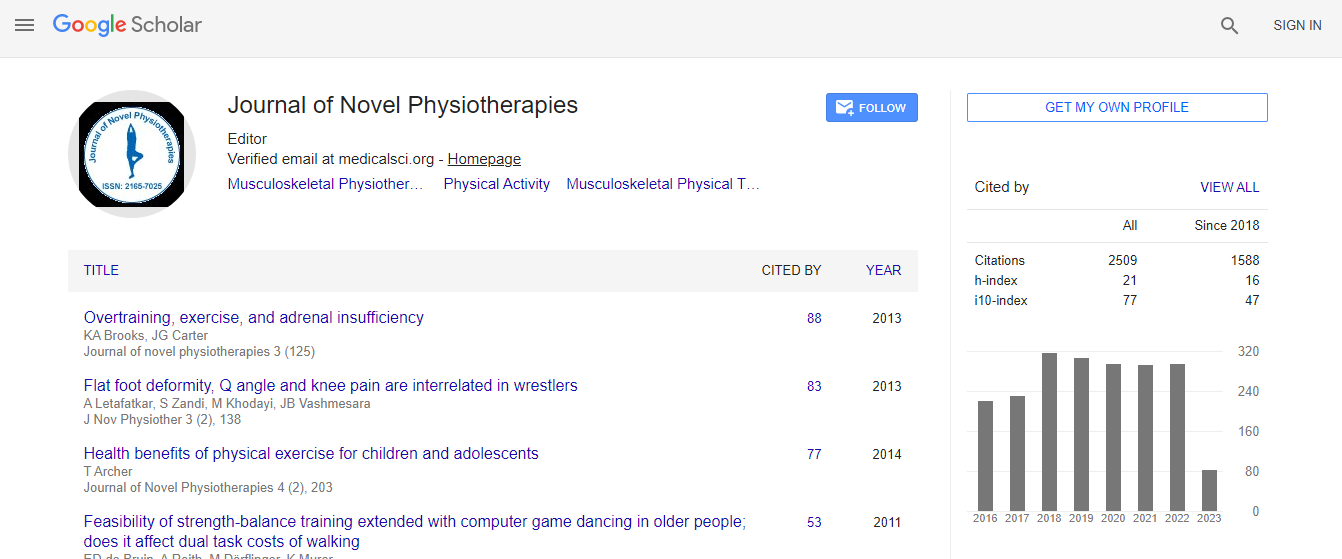Our Group organises 3000+ Global Events every year across USA, Europe & Asia with support from 1000 more scientific Societies and Publishes 700+ ������ Journals which contains over 50000 eminent personalities, reputed scientists as editorial board members.
������ Journals gaining more Readers and Citations
700 Journals and 15,000,000 Readers Each Journal is getting 25,000+ Readers
Citations : 3145
Indexed In
- Index Copernicus
- Google Scholar
- Open J Gate
- Genamics JournalSeek
- Academic Keys
- SafetyLit
- RefSeek
- Hamdard University
- EBSCO A-Z
- OCLC- WorldCat
- Publons
- ICMJE
Useful Links
Recommended Journals
Related Subjects
Share This Page
Comparison of Mini-BESTest versus Berg Balance Scale to evaluate balance disorders in Parkinsons disease
2nd International Conference and Expo on Novel Physiotherapies
R Harihara Prakash, Shweta R Parikh and Sangna S Sheth
Sardar Patel University, India
ScientificTracks Abstracts: J Nov Physiother
DOI:
Abstract
Aim: The purpose of this study was to explore the usefulness of the Mini-BESTest compared to the Berg Balance Scale in evaluating balance in people with Parkinson's Disease (PD) of varying severity. Evaluation was done to obtain (1) the distribution of patients scores to look for ceiling effects, (2) concurrent validity with severity of disease, and (3) the sensitivity & specificity of separating people with or without postural response deficits. To Compare the Mini-BESTest versus Berg Balance Scale and to evaluate balance disorders in Parkinson's Disease. Settings & Design: A cross sectional study was conducted at K M Patel Institute of Physiotherapy (KMPIP), Shree Krishna Hospital, Karamsad. Material & Methods: Seventy-seven (77) people with Parkinson's Disease were tested for balance deficits using the Berg Balance Scale, Mini-BESTest. Unified Parkinson��?s Disease Rating Scale (UPDRS) III and the Hoehn & Yahr (H&Y) disease severity scales were used for classification. Materials used in this study were case record sheet, chair without arm rests or wheels, incline ramp, stopwatch, a box, 3 meter distance measured out and marked on the floor with tape [from chair]. Statistical analysis was done by multiple linear regression whcih was carried out of UPDRS jointly on the two scores for the Berg and Mini-BESTest. Receiver operating characteristic curves for classifying people into two groups based on a threshold for the H&Y score, to discriminate between mild PD versus more severe PD. Correlation co-efficient was used to find relativeness between the two variables. Results: The Mini-BESTest is highly correlated with the Berg (r=0.732, P<0.001), but avoids the ceiling compression effect of the Berg for mild PD (skewness ��?0.714 Berg, ��?0.512 Mini-BESTest). Consequently, the Mini-BESTest is more effective than the Berg for predicting UPDRS Motor score (P<0.001 Mini-BESTest versus P=0.72 Berg), and for discriminating between those with and without postural response deficits as measured by the H&Y (ROC). Conclusions: The Mini-BESTest is a promising tool for identifying balance deficits in patients with Parkinson's disease, most importantly those with deficits which are more difficult to analyze.Biography
R Harihara Prakash is the Principal and Professor at K M Patel Institute of Physiotherapy, Karamsad. He has 18 years of professional experience in clinical as well as academics. He is a Doctorate in Physical Therapy from National University of Medical Sciences, Spain. He was awarded with “Rashtriya Vidhya Saraswathi Puraskar Award” for his excellent contribution in academics. He was former Dean, Faculty of Physiotherapy, Baba Farid University of Health Sciences, Punjab. He is in the editorial board and peer reviewer for some international journals. He is also in the panel of NAAC. He has obtained various skills by certification in the field of neurology, osteopathy, manual therapy from various countries. He has published and presented research papers in various national and international conferences. He is an eminent speaker and an academician.
Email: saihari76@gmail.com

